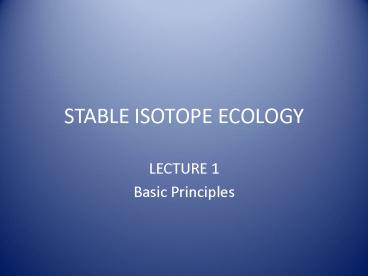STABLE ISOTOPE ECOLOGY - PowerPoint PPT Presentation
1 / 29
Title:
STABLE ISOTOPE ECOLOGY
Description:
There are different atomic configurations for a single element. ... It is a belemnite formation and the carbon isotope ratio of the CO2 liberated ... – PowerPoint PPT presentation
Number of Views:299
Avg rating:3.0/5.0
Title: STABLE ISOTOPE ECOLOGY
1
STABLE ISOTOPE ECOLOGY
- LECTURE 1
- Basic Principles
2
WHAT ARE STABLE ISOTOPES?
- What are stable isotopes?
- Elements of interest
- How do we measure stable isotope abundance
- How is stable isotope abundance expressed.
- Isotope fractionation
- Rayleigh distillation effects
3
What are stable Isotopes?
- There are different atomic configurations for a
single element. Atomic configurations that
differ only in the number of neutrons in the
nucleus are called isotopes.
Protium
Deuterium
Tritium
Hydrogen
4
Stable and Unstable Isotopes
Tritium is unstable decays to 3He (Radioisotope)
Deuterium is stable does not decay (Stable
Isotope)
5
Elements of Interest
- 1H light stable isotope of hydrogen (99.985)
- 2H (D)heavy stable isotope of hydrogen (.015)
- 12C light stable isotope of carbon (98.9)
- 13Cheavy stable isotope of carbon (1.1)
- 16Olight stable isotope of oxygen (99.759)
- 18Oheavy stable isotope of oxygen (.204)
- 17Oheavy stable isotope of oxygen (.037)
6
- 14N light stable isotope of nitrogen (99.63)
- 15Nheavy stable isotope of nitrogen (.37)
- 32S light stable isotope of sulfur (95.0)
- 33Sheavy stable isotope of sulfur (0.76)
- 34Sheavy stable isotope of sulfur (4.22)
- 36Sheavy stable isotope of sulfur (0.014)
7
(No Transcript)
8
Mass Balance Equation
- The atomic weight of an element is the average of
each isotope weighted to its abundance. - For Example
- Atomic mass of Carbon (12 x 0.989)(13 x 0.011)
12.011
9
Measurement of Stable Isotope Abundance
Mass Spectrometer
Tunable Lazer Diode
10
Mass Spectrometry
11
Tunable Laser Diode
12
Sample Prep
- Isotope Ratio Mass Spectrometers can only
directly analyze simple gas molecules like - H2
- CO2
- SO2
- N2
- CO
- Therefore complex organic molecules must be
broken down to the simpler gas molecules.
13
Elemental Analyzers
Elemental Analyzer
Convert complex molecules to simple gas forms.
Mass Spectrometer
14
Oxygen and Hydrogen Isotope Ratios of Water
- Water is a very sticky molecule and cannot be
analyzed directly. Indirectly analyzed by
equilibration with either hydrogen gas (hydrogen
isotope ratios) or carbon dioxide (oxygen isotope
ratios). Gas is introduced into sealed tubes and
allowed to equilibrate with the water for a
period of time. Aliquot of gas is taken and
analyzed either for hydrogen or oxygen isotope
ratios and back-calculated to either hydrogen or
oxygen isotope ratios of water.
CO2 H2O
H -HCO2O
H2O H2
H2O H2
15
Multiflow Gas System
Mass Spectrometer
Water equilibrated with either CO2 or H2
16
EXAMPLE DATA FROM ISOTOPIC ANALYSIS.
17
HOW DO WE EXPRESS THE QUANTITY OF ISOTOPE IN A
SAMPLE?
Samples are always analyzed in conjunction with
standard gases calibrated to an accepted global
standard of isotope abundance.
Carbon the standard is abbreviated as PDB which
stands for the Pee Dee Formation of South
Carolina. It is a belemnite formation and the
carbon isotope ratio of the CO2 liberated from
the reaction with acid is considered a universal
standard. 13C/12C 0.01124.
Oxygen and Hydrogen the standard is abbreviated
as SMOW which stands for standard mean ocean
water. 18O/16O0.0020052 and D/H0.00015575
18
UNIT OF MEASUREMENT
Where I is the heavier isotope, I is the lighter
isotope (the ratio I/I is usually abbreviated as
R) and xx is the atomic weight of the heavier
isotope. For Example
19
Variation in d values
0
1
2
3
-3
-1
-2
RsamplegtRstandard
RsampleltRstandard
RsampleRstandard
20
HOW ACCURATE CAN WE MEASURE STABLE ISOTOPE
ABUNDANCES?
Typical precision of carbon isotope ratio
measurement is 0.1. What does this means in
terms of how accurate we can measure the
percentage of 13C? It means we can measure a
minimum difference between two samples of 0.1.
0.1((Rsample1/0.01124)-1)1000 Solving for
Rsample1
0.0((Rsample2/0.01124)-1)1000 Solving for
Rsample2
Rsample1-Rsample20.0112411-0.011240.00000124 or
0.000124
VERY SENSITIVE INDEED!
21
EXERCISE QUESTIONS
C4 plants are about 10 more enriched than C3
plants. What is the difference in percentage 13C
between C3 and C4 plants? Is R the same as 13C
percentage in a sample? What is the
relationship between d13C and 13C percentage?
22
ISOTOPIC FRACTIONATION
The unequal processing of two isotopes of the
same element in any physical process and/or
chemical reaction of an element or a compound.
A B A B
TWO MAJOR TYPES OF ISOTOPIC FRACTIONATONS
EQUILIBRIUM ISOTOPIC FRACTIONATION KINETIC
ISOTOPIC FRACTIONATION
23
MATHEMATICAL EXPRESSION OF FRACTIONATION FACTORS
ax-yRx/Ry
Equilibrium Fractionation
Kinetic Fractionation
X Y
X Y
EXAMPLES
H2Oliquid H2Ovapor
RuBisPCO2 (CH2O)n
awater-vaporRwater/Rvapor
aCH2O-CO2RCH2O/RCO2
awater-vapor 1.009
aCH2O-CO2 0.973
24
EQUILIBRIUM FRACTIONATION
LIQUID
VAPOR
25
DIFFERENT MATHEMATICAL EXPRESSION FOR
FRACTIONATION
GOING FROM a TO d IS AWKWARD
SEPARATION FACTOR Dx-ydx-dy
ENRICHMENT FACTOR
ex-y (ax-y-1)103
ex-y Dx-y 103lnax-y
26
EXERCISE QUESTIONS
What is the oxygen isotope fractionation factor
between water and vapor at 25oC and 45oC? Use
the table and equation given in the
handout. What is the enrichment (e) and
separation (D) factor? Do the same for hydrogen
isotope fractionation.
27
MASS BALANCE PRINCIPLE
Stable isotopes are neither created or destroyed
in a conventional physical or chemical
process. n1A n2B n3C
n4D n5E n6F We know that
Nn1n2n3n4n5n6 (dAn1/N)(dBn2/N)(dCn3/N)(d
Dn4/N)(dEn5/N)(dFn6/N)
28
RAYLEIGH DISTILLATION EFFECT
IF THE AMOUNT OF SUBSTRATE IS QUANTITATIVELY
CONSUMED BY A REACTION THERE WILL BE NO
FRACTIONATION. THIS IS EXPRESSED MATHEMATICALLY
AS THE RAYLEIGH EQUATION. dsubstrate(f)
dsubstrate(0) ep-s.ln f Where f is the
residual fraction of the substrate after the
reaction has occurred for some time. WHAT IS
THE ISOTOPE RATIO OF THE PRODUCT? WHAT IS THE
CUMULATIVE ISOTOPE RATIO OF THE PRODUCT? (hint
use the mass balance approach i.e. isotopes are
not created or destroyed in conventional chemical
and physical reactions.
29
d cumulative product
d product
e
d value
d substrate
0
1
Fraction of Substrate Remaining































